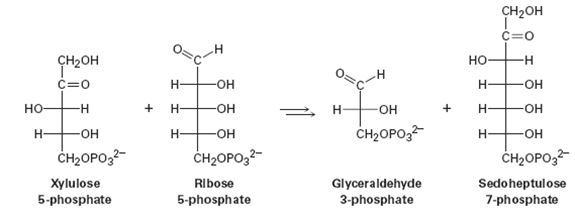
Concept explainers
One of the steps in the pentose phosphate pathway for glucose catabolism is the reaction of xylulose 5-phosphate with ribose 5-phosphate in the presence of a transketolase to give glyceraldehyde 3-phosphate and sedoheptulose 7-phosphate.

(a) The first part of the reaction is nucleophilic addition of thiamin diphosphate (TPP) ylide to xylulose 5-phosphate, followed by a retro-aldol cleavage to give glyceraldehyde 3-phosphate and a TPPcontaining enamine. Show the structure of the enamine and the mechanism by which it is formed.
(b) The second part of the reaction is addition of the enamine to ribose 5-phosphate followed by loss of TPP ylide to give sedoheptulose 7-phosphate. Show the mechanism.
Trending nowThis is a popular solution!

Chapter 29 Solutions
OWLv2 with Student Solutions Manual eBook, 4 terms (24 months) Printed Access Card for McMurry's Organic Chemistry, 9th
Additional Science Textbook Solutions
College Physics: A Strategic Approach (3rd Edition)
Physical Science
Organic Chemistry
Applications and Investigations in Earth Science (9th Edition)
- Q9. The insecticide DDT (in the box below) is useful in controlling mosquito populations and has low toxicity to humans, but is dangerous to birds and fish. Hoping to alleviate the dangers, little Johnny Whizbang, an aspiring chemist, proposes a new version of DDT ("Bromo-DDT") and shows his synthesis to his boss. Will Johnny Whizbang's synthesis work? Or will he be fired? Assume there is an excess of bromine and polybrominated products can be separated. Explain why. CH3 Br2, light CBR3 ok-ok Br Br Br Br CI "Bromo-DDT" CCl 3 DDT (dichlorodiphenyltrichloroethane) CIarrow_forwardDifferentiate the terms Monotectic, Eutectic, Eutectoid, Peritectic, Peritectoid.arrow_forwardQ5. Predict the organic product(s) for the following transformations. If no reaction will take place (or the reaction is not synthetically useful), write "N.R.". Determine what type of transition state is present for each reaction (think Hammond Postulate). I Br₂ CH3 F2, light CH3 Heat CH3 F₂ Heat Br2, light 12, light CH3 Cl2, lightarrow_forward
- a. For the following indicated bonds, rank them in order of decreasing AH° for homolytic cleavage. Based on your answer, which bond would be most likely to break homolytically? (a) (c) H3C CH3 .CH3 CH3 CH3 (b) Page 1 of 5 Chem 0310 Organic Chemistry 1 Recitations b. Draw all the possible radical products for 2-methylbutane, and determine which bond is most likely to be broken.arrow_forwardA 5-m³ rigid tank contains 5 kg of water at 100°C. Determine (a) the pressure, (b) the total enthalpy, and (c) the mass of each phase of water.arrow_forwardQ8. Draw the mechanism for this halogenation reaction. Show all steps including initiation, propagation, and recombination. Cl₂, hv CI Br Br2, hv, heatarrow_forward
- Q6. Given the following alkanes, draw the most likely product to form upon monohalogenation with Br2 (keep in mind that this may not be the only product to form though). If the reaction was performed with Cl2 would there be more or less selectivity in the desired product formation? Why? (a) (b) (c)arrow_forwardQ4. Radicals a. For the following indicated bonds, rank them in order of decreasing AH° for homolytic cleavage. Based on your answer, which bond would be most likely to break homolytically? (c) CH3 CH3 H3C CH3 (a) CH3 (b)arrow_forwardQ1. (a) Draw equations for homolytic and heterolytic cleavages of the N-H bond in NH3. Use curved arrows to show the electron movement. (b) Draw equations for homolytic and heterolytic cleavages of the N-H bond in NH4*. Use curved arrows to show the electron movement.arrow_forward
- ohing Quantitative Relationships 425 The specific heats and atomic masses of 20 of the elements are given in the table below. Use a graphical method to determine if there is a relationship between specific heat and the atomic mass. a. b. C. d. e. If your graphs revealed relationship between specific heat and atomic revealed a mathematical mass, write down an equation for the relationship. Comment on the usefulness of the determination of specific heat as a method for identifying an element. Would specific heat alone give you much confidence with regard to the identity of the element? If you think measurement of another property would be needed to support an identification, what property would you measure and why? The elements listed in the table are all selected metals. The values for nitrogen, oxygen, fluorine and neon are 1.040, 0.918, 0.824 and 1.030 J/g K respectively. Do these elements fit your equation? element atomic mass specific heat (almol) (Jig K) magnesium 24.305 1.023…arrow_forwardPlease correct answer and don't use hand rating and don't use Ai solutionarrow_forwardNonearrow_forward
